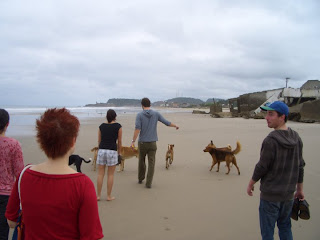Well that last blog seems to have put the wind up some people, but that was just how I was feeling at that moment. I had an email from one person concerned about life here at Playa Kamala, so I tried to give them a more balanced view, this is an edited version of the response I gave them.
The cabanas are pretty ‘rustic’, but I am in a two story one with my wife, I believe the single story ones that most people have are a bit cosier. At the moment the weather isn't that great, it is fairly damp, and the cabinas are built to let the air in for when it is hot, so we had a problem with the rain coming in and soaking everything. But the handyman here fixed it with some plastic sheeting. Things get a bit dirty because your feet get muddy walking around outside, so you have to sweep out the sand periodically.
There are not many spiders, we have only seen a few small ones, but there have been several sightings of scorpions in the cabanas. One person found a scorpion on their toothbrush this morning. Though, you don't see that many insects at all, and most people are not even bothering with repellent. Though a minority seem to be getting lots of bites from something. The constrictor snake is apparently out there, but nobody has seen it for a while and I don't think it is a risk to humans. The local creatures are not all bad, we can see whales from the site at the moment, even sometimes from the classroom (read as big cabina). There are also two nice dogs that live here and a cat with two kittens. The dogs regularly come into the classes and then sit there in the centre of the room licking themselves.
The only hot water is in your shower in the cabana, that apparently runs out frequently, but I haven't noticed it run out in the time I have been here. There was a bit of a crisis the day before I wrote that last blog, when we were told that the electric system was failing and there might be far more limited hot water and IT facilities. But that crisis seems to have dissipated for the moment.
The IT facilities are fairly limited. There is a basic photocopier; they really should have a better one. There are three PCs and two printers, but having all turned on at the same time blows the electrics, so two PCs maximum at the moment. You need to use those two PCs to print out from, but otherwise most people work on their laptops. There is Wi-Fi reception in all the cabanas, but it can be painfully slow at times, and it never gets very fast. However, many people are managing to use it to Skype home.
As for escaping from the site, it is just that we spend all our time together on a fairly small location. It makes sense to try and do other stuff at the weekends, just to clear your head before the next week starts. The problem is that there isn't that much nearby. Montañita is fairly close; most people go in a couple of times a week for shopping. It is a 20 minute walk down the beach, and then two dollars back in a taxi (with shopping). Montañita is a very boozy, back-packer and surfer town. So some people will love it, others will avoid it. Activities can be organised here at Kamala as a group, it will be down to you or another student to arrange something, but the staff of the Kamala sight can help with that. We are all going snorkeling and whale watching this weekend, for example.
Overall it is not too bad. Character building they call it, and we will all have characters
built like brick shit houses by the time we have finished.











